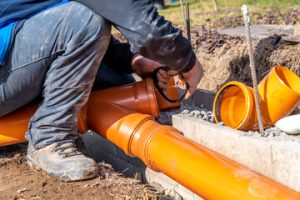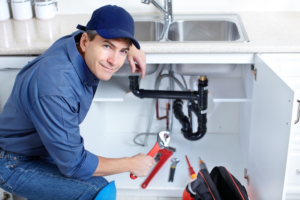The plumbing industry continues to evolve, reducing the need for disruptive excavation with new trenchless repair methods. These techniques preserve landscaping, driveways and patios from costly destruction.

Foul odors, slow drains and gurgling sounds from toilets are sure signs that the sewer line needs repair or replacement. The type of repair needed depends on the scope of damage.
Trenchless methods for sewer line repair require less digging on your property and can be performed more quickly than traditional methods. These methods can save you money on the cost of excavation equipment and labor, as well as landscaping and concrete repairs afterward. They are also more environmentally friendly than traditional methods, which may involve tearing up your yard and dumping the dirt elsewhere on your property.
Compared to the multiple days or even weeks required for traditional sewer line repair, trenchless methods only take a few hours or a couple of days. This makes them much more convenient for homeowners who need to get their sewer lines repaired as soon as possible.
Two common types of trenchless sewer line repair are pipe lining and pipe bursting. Both of these techniques work by digging just a few access holes near the beginning and end of the damaged piping run. Then, a tech feeds a flexible tube coated with resin through the hole and blows or pulls it into place inside the damaged pipe. The resin will harden around the tube, creating a pipe within a pipe and leaving you with a new, durable piping solution that can last decades.
Other trenchless options for sewer repair include CIPP (cured-in-place pipe) and relining. CIPP repairs use a layer of specialized epoxy to coat the interior surface of your damaged pipes and prevent leaks or blockages. It also creates a strong, durable pipe that will hold up to corrosion and other issues.
Relining uses a similar process to CIPP, except the technician inserts a liner into the entire interior of the pipe. This liner will protect the interior of your pipe and create a smooth surface that can resist damage or clogs for decades.
Trenchless sewer line repair can also benefit your home’s value. Potential buyers are often turned off by the thought of having to dig up their yard for extensive sewer repairs, but trenchless methods allow you to keep your landscape pristine while getting your broken pipes fixed.
Both the pipe lining and pipe bursting processes are effective for repairing a variety of conditions, including damaged, clogged, or collapsed pipes. However, it is important to understand that these methods won’t fix certain problems such as sagging or bellying pipes, or those that are too severely damaged. If you have a more severe problem with your sewer line, it is important to hire a professional to dig up and replace the existing pipe.
Pipe Lining
Cured-in-Place Pipe (CIPP) lining is an innovative way to restore worn out sewer lines without extensive digging. It uses a flexible tube coated in epoxy resin that is inserted into the damaged pipe and then inflated. Once cured, it creates a seamless liner that eliminates joints and has a service life of decades. This method of trenchless repair is highly effective and cost-efficient for both residential and commercial properties.
Professional plumbers use a camera to inspect the condition of your pipes and determine if they can be repaired using CIPP. After that, they remove any tree roots or debris that are causing blockages. They also clean the inside of the pipe and flush it with water to remove any remaining debris or clogs. They also use the camera to verify that the new lining has fully adhered to the walls of the existing pipe.
This process is much faster and cheaper than traditional excavation methods for sewage pipe repairs. It can also save property owners on utility bills because it prevents leakage of sewage into the environment. This method of trenchless repair can be used on pipes made of any material, including concrete, cast iron, and PVC.
One of the most significant benefits of CIPP is that it allows for the replacement of lateral connections to the main sewer line without requiring invasive trenching. The CIPP lining can also be used to repair cracked or leaking sewer pipes within the home that are too damaged for other repairs.
During the CIPP process, it is important to limit water use and shut off any sump pumps connected to the sewage system. It is also important to drain all appliances such as washing machines and dishwashers prior to the relining process. You can also minimize your water usage by not running or flushing anything down the toilet during this time.
During the CIPP process, a technician inserts an inflatable tube coated in epoxy into the sewer pipe. The pipe is inflated and exposed to steam heat, which causes the resin to bond with the interior of the pipe. Once cured, the pipe is ready for use and no longer leaks or breaks.
Pipe Bursting
If your sewer line is damaged and needs to be replaced, you’ll want to choose a method that offers a long-term solution that strengthens the entire line. This is the only way to guarantee longevity and prevent recurring problems in the future. Unlike pipe lining, which reduces the diameter of the existing pipe, pipe bursting replaces the old pipes altogether. In this method, a contractor inserts a new, heat-welded pipe through a small entry and exit point above ground. The insertion point is connected to a cone-shaped “bursting head.” As the bursting head breaks up the existing pipes and shifts the debris into the surrounding soil, it simultaneously pulls behind it a new, larger-diameter pipe.
While this process may seem intimidating, it is much faster and more efficient than traditional excavation methods. Plus, it causes less damage to the surrounding environment, resulting in less cleanup and repair work. This is why we recommend choosing this trenchless technique for your next sewer line replacement project.
As a homeowner, you know that a damaged or faulty sewer line can be quite problematic. From an environmental perspective, a broken line can result in toxic sewage leaking into the environment. Additionally, a broken sewer line can lead to costly repairs and expensive cleanup for the home owner. Fortunately, new technology has revolutionized how this important task is done.
Until recently, replacing a damaged sewer line required excavation-based techniques. These involved digging up your property’s landscaping and exposing the damaged line for repair or replacement. This process was not only time-consuming, but it also caused major disruption to your home and garden.
Trenchless techniques are now a popular and viable option for homeowners in need of a quick and effective sewer repair. One of the most exciting and innovative methods available is called pipe bursting. While there are many benefits to this trenchless method, it is not without its myths and misconceptions. In this blog post, we will discuss three common myths about pipe bursting and how it works to fix your home’s sewer lines.
If your sewer line is in need of repair, contact the team at SLB Pipe Solutions today. We can help you find the best solution for your unique situation.
Traditional Method
If you’re experiencing problems with your sewer line, it’s important to recognize them quickly. Common signs of a damaged or deteriorating sewer line include slow drains, foul odors, and frequent blockages and backups. Recognizing these warning signs early can help you avoid more extensive repair costs in the future.
Traditional excavation is one method of sewer line repair that’s commonly used to address a variety of issues. It involves digging large trenches around the damaged area and removing old or corroded pipes before installing new ones. This method can be expensive and time-consuming, but it’s a great option for dealing with severe damage or extensive blockages that require comprehensive repairs.
Another option for addressing a faulty sewer line is to install a cured-in-place pipe (CIPP). This technique coats an existing pipe with an epoxy resin, repairing cracks and voids. It’s a durable solution that can significantly extend the lifespan of your pipes.
Regardless of the method you choose, it’s essential to consider the effects on the environment during a sewer line repair project. Whether it’s through trenchless methods or traditional excavation, any disturbance to the ground can lead to soil erosion, runoff, and other environmental concerns. As a result, it’s vital to use eco-friendly materials for your new pipes and adhere to environmental standards during the installation process.
While both trenchless and traditional methods can successfully repair a faulty sewer line, there are times when excavation is the only viable option. Severe damage, expansive blockages, and other unforeseen circumstances may make it necessary to dig up a section of your sewer line. If you’re unsure of what type of repair is best for your sewer system, consult with a professional to ensure it meets your needs and budget.
When you need sewer repair, it’s best to contact a professional right away. They’ll be able to determine the best method for your specific situation and provide a cost estimate upfront. While traditional excavation can be time-consuming and expensive, trenchless methods are a great alternative that save on labor, restoration, and long-term maintenance expenses.
